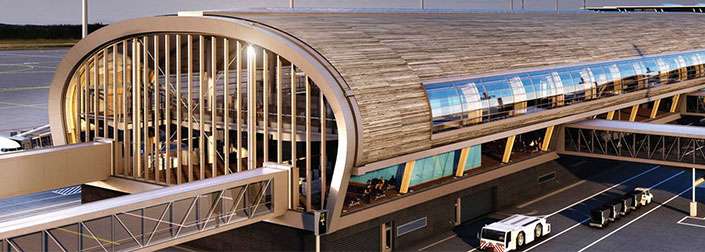Oslo International Airport - Terminal 2
The new Oslo International Airport was built in 1998 to handle 17 million passengers per year. The increasing number of passengers over the last decade led Avinor, the company responsible for the state-owned airports in Norway, to approve an expansion plan. With a budget of USD 1.8 billion, the project started in spring 2011 and is scheduled to be completed in April 2017. By adding 117000 m2 to the existing 148000 m2, the Oslo airport will be ready to accommodate 28 million passengers per year.
Planning is crucial
Professional planning is crucial since the project is being executed during full operations of a large international airport. Adding new infrastructure and integrating with existing operations requires detailed and precise planning. During the construction of the new terminal, the airport will operate at its peak capacity of 65 aircraft movements per hour.
At the start of the project, Avinor selected Safran Planner, a lighter scheduling tool suitable for providing full project overview. To support more efficient project management methods and detailed follow up of project progress, Avinor migrated to Safran Project as the main planning tool. Safran Project is a comprehensive project control solution and a reliable planning tool that is a designed to add value at every stage of the project execution.
A complex project
With the addition of Terminal 2, Oslo International Airport will be capable of adding new capacity for airlines. Adding and integrating new infrastructure, e.g. new buildings, baggage systems, piping and wiring routing, to those already in operation is a very complex project to execute successfully. Furthermore, there are commercial services including 70 restaurants, shops, lounges, banks, etc.
Construction planning and execution
Avinor, as the airport owner, established a project organization with responsibility for engineering, procurement, construction and commissioning. A key responsibility of the project organization is to communicate with Avinor on the construction project status and forecast. Such a large multidisciplinary project normally requires involvement of various contractors with different specialties. In the construction phase, the project planning team used Safran Project to plan the activities broken down by contract, and track progress and deviations from the plan on a proactive basis.
“Activity progress collected from contractors and consolidated in Safran Project allows us to identify any part of the project that falls behind schedule, and take action. Keeping up with 30+ large contracts without a capable tool like Safran Project would be challenging at best.”
- Fredrik Liltvedt Head of Project Services, OSL T2
Capable software
Safran’s powerful project planning capabilities allow the planning team to create unlimited projects, sub-projects, activities, links, summary levels and baselines. Having unlimited baselines together with filtering and grouping capabilities provides the planning team with flexibility in reporting and added insight into changes over the full project lifecycle.
Safran Project is an important component to Terminal 2 at the Oslo International Airport becoming a successful reality.


